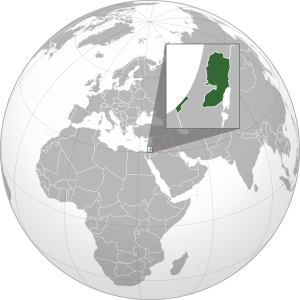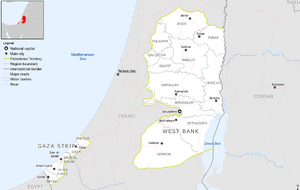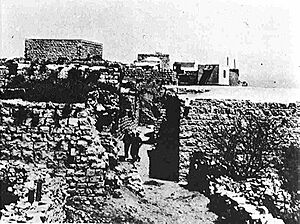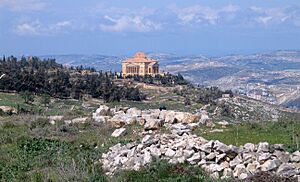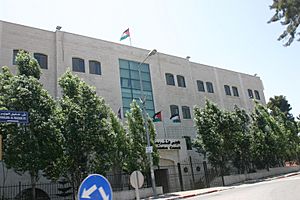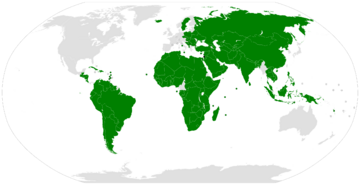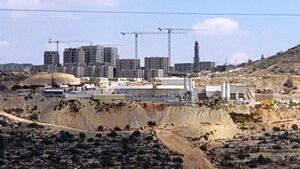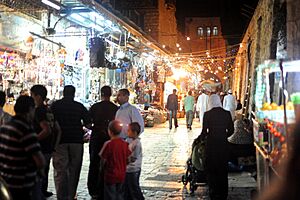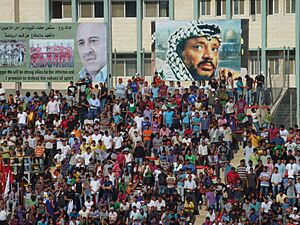Palestine facts for kids
Quick facts for kids
State of Palestine
|
|
|---|---|
|
Anthem: فدائي
(Fidāʾī; "Warrior") |
|
|
Occupied Palestinian territories Territory annexed by Israel
|
|
| Status | UN observer state under Israeli occupation Recognized by 157 UN member states |
|
|
| Largest city | Gaza (before 2023) |
| Official languages | Arabic |
| Ethnic groups
(2007)
|
|
| Religion
(2020)
|
|
| Demonym(s) | Palestinian |
| Government | Semi-presidential republic |
| Mahmud Abbas | |
| Hussein al-Sheikh | |
| Mohammad Mustafa | |
| Legislature | Legislative Council |
| Formation | |
|
• Declaration of Independence
|
15 November 1988 |
|
• Sovereignty dispute with Israel
|
Ongoing |
| Area | |
|
• Total
|
6,020 km2 (2,320 sq mi) (163rd) |
|
• Water (%)
|
3.5 |
| 5,655 km2 | |
| 365 km2 | |
| Population | |
|
• 2023 estimate
|
5,483,450 (121st) |
|
• Density
|
731/km2 (1,893.3/sq mi) |
| GDP (PPP) | 2023 estimate |
|
• Total
|
|
|
• Per capita
|
|
| GDP (nominal) | 2021 estimate |
|
• Total
|
|
|
• Per capita
|
|
| Gini (2016) | ▼ 33.7 medium |
| HDI (2023) | medium · 133rd |
| Currency | |
| Time zone | UTC+2 (Palestine Standard Time) |
|
• Summer (DST)
|
UTC+3 (Palestine Summer Time) |
| Calling code | +970 |
| ISO 3166 code | PS |
| Internet TLD | .ps |
Palestine, officially the State of Palestine, is a country in the Middle East region of West Asia. It is made up of two main areas: the West Bank and the Gaza Strip. These areas are known as the Palestinian territories. A majority of countries in the United Nations recognize Palestine as an independent state.
The West Bank shares a border with Jordan to the east, while the Gaza Strip is on the coast of the Mediterranean Sea, with Egypt to the southwest. The rest of Palestine's borders are with Israel. The city of Jerusalem is claimed as the capital, but the main administrative city is Ramallah.
The region of Palestine has a very long history and is considered holy by Christians, Jews, and Muslims. For centuries, it was ruled by many different empires. The modern conflict in the region began over a century ago. After World War I, the area, which was part of the Ottoman Empire, came under British control. During this time, many Jewish people moved to the region, which led to tensions with the Arab people already living there.
In 1948, a war led to the creation of the state of Israel. This event caused many Palestinians to leave their homes. Palestinians call this the Nakba, which means "catastrophe." In a war in 1967, Israel occupied the West Bank and the Gaza Strip.
In 1988, the Palestine Liberation Organization (PLO) declared the independence of the State of Palestine. In the 1990s, peace talks called the Oslo Accords created the Palestinian Authority (PA) to govern parts of the West Bank and Gaza. However, political disagreements led to a split. Today, the PA governs parts of the West Bank, while the group Hamas controls the Gaza Strip.
In October 2023, attacks by armed groups from Gaza led to a major war. This war has caused a terrible humanitarian crisis in the Gaza Strip. Many people have lost their lives, homes, and access to food and water. Many international organizations have described the situation as a severe crisis for the Palestinian people.
Contents
What's in a Name?
The name "Palestine" comes from an ancient Greek word, Palaistina. The Greek historian Herodotus used this name over 2,000 years ago to describe the area. It is related to the name of the Philistines, an ancient people who lived along the coast.
In this article, the terms "Palestine," "State of Palestine," and "occupied Palestinian territory" are used to talk about the same place. The term "occupied Palestinian territory" refers to the areas that have been occupied by Israel since 1967.
History
Ancient Times to Ottoman Rule
The land of Palestine has been home to people for thousands of years. Because of its location between Africa, Asia, and Europe, many empires have ruled over it. Ancient Egyptians, Babylonians, Romans, and others all controlled this area at different times. It is a holy land for Jews, Christians, and Muslims, and many important religious events happened here.
For about 400 years, from 1517 to 1917, Palestine was part of the powerful Ottoman Empire. During this time, people of different religions lived together in the region.
British Rule and Growing Tensions
After the Ottoman Empire was defeated in World War I, Great Britain took control of Palestine. This period was called the British Mandate. During this time, the Zionist movement, which wanted to create a Jewish homeland, grew stronger. More Jewish people began moving to Palestine from other parts of the world.
This led to conflict between the new Jewish immigrants and the Palestinian Arabs who already lived there. Both groups wanted to have their own country in the same land. There were many protests and violent clashes during the 1920s and 1930s.
In 1947, the newly formed United Nations proposed a plan to divide Palestine into two states: one for Arabs and one for Jews. The Jewish leaders accepted the plan, but the Arab leaders rejected it.
Wars and the Creation of Israel
When the British left in 1948, Jewish leaders declared the creation of the State of Israel. Neighboring Arab countries, along with Palestinian Arabs, went to war with the new state. This is known as the 1948 Arab–Israeli War.
During the war, Israel took control of more land than the UN plan had given it. Hundreds of thousands of Palestinians fled or were forced to leave their homes, becoming refugees in nearby countries. This event is known as the Nakba. After the war, the West Bank was controlled by Jordan, and the Gaza Strip was controlled by Egypt.
In 1967, another war called the Six-Day War took place. Israel fought against Egypt, Jordan, and Syria. After the war, Israel occupied the West Bank and the Gaza Strip.
The PLO and the Fight for a State
In 1964, the Palestine Liberation Organization (PLO) was formed. Its goal was to create an independent state for Palestinians. For many years, the PLO was led by Yasser Arafat.
In 1987, Palestinians in the West Bank and Gaza began a major uprising against the Israeli occupation. This was called the First Intifada. It involved protests, strikes, and clashes with Israeli soldiers.
A year later, in 1988, the PLO officially declared the independence of the State of Palestine. Many countries around the world recognized it.
Peace Efforts and More Conflict
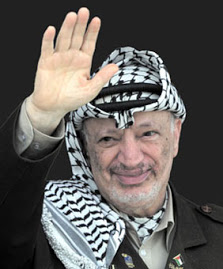
In 1993, Israel and the PLO signed the Oslo Accords. This was a major step toward peace. The agreement created the Palestinian National Authority (PA) to govern parts of the West Bank and Gaza. However, the most difficult issues, like the status of Jerusalem and the rights of Palestinian refugees, were left for later talks.
The peace process faced many challenges. Some groups on both sides were against the agreements, and attacks continued. In 2000, a second, more violent uprising called the Second Intifada began.
In 2005, Israel withdrew its soldiers and settlers from the Gaza Strip. But a year later, a conflict broke out between the two main Palestinian political groups, Fatah and Hamas. Hamas took control of Gaza, while Fatah remained in control of the PA in the West Bank. This division has continued ever since.
Since 2007, Israel has maintained a blockade on the Gaza Strip, controlling what goes in and out. This has made life very difficult for the people living there. The conflict continued with several wars in Gaza. In October 2023, a major war began, causing widespread destruction and a severe humanitarian crisis.
Geography and Nature
Palestine is located in a region called the Levant. It consists of two separate areas: the West Bank and the Gaza Strip.
The West Bank is a landlocked area with hills and mountains. It includes parts of the Judean Hills and the Samarian Hills. The famous Jordan River flows along its eastern border. The Dead Sea, the lowest point on Earth, is also on this border. The city of Jericho, one of the oldest cities in the world, is located nearby.
The Gaza Strip is a narrow piece of land along the Mediterranean Sea. It has a flat landscape with sandy beaches.
The climate is mostly Mediterranean, with hot, dry summers and mild, rainy winters. Palestine is home to many ancient olive trees, and about 45% of its farmland is used for growing olives.
Government and Politics
Palestine is governed as a semi-presidential republic. The government is made up of several parts. The Palestine Liberation Organization (PLO) represents all Palestinians worldwide and acts as the government in international matters.
The Palestinian National Authority (PA) governs the parts of the West Bank under Palestinian control. The president of the State of Palestine is also the president of the PA. Since 2005, the president has been Mahmoud Abbas.
Since 2007, there has been a political split.
- The West Bank is mainly governed by the PA, which is led by the Fatah party.
- The Gaza Strip is controlled by Hamas, an Islamic political and militant group.
Palestine's claimed capital is Jerusalem. However, because of the ongoing conflict, the main government offices are in the city of Ramallah.
Administrative Divisions
Palestine is divided into 16 governorates, which are like states or provinces. Eleven are in the West Bank, and five are in the Gaza Strip.
The West Bank is also divided into three zones, known as Areas A, B, and C, based on the Oslo Accords:
- Area A is fully controlled by the Palestinian Authority.
- Area B is under Palestinian civil control, but security is shared with Israel.
- Area C is fully controlled by Israel. Most Israeli settlements are in Area C.
| Name | Area (km2) | Population | District Capital |
|---|---|---|---|
| Jenin | 583 | 311,231 | Jenin |
| Tubas | 402 | 64,719 | Tubas |
| Tulkarm | 246 | 182,053 | Tulkarm |
| Nablus | 605 | 380,961 | Nablus |
| Qalqiliya | 166 | 110,800 | Qalqilya |
| Salfit | 204 | 70,727 | Salfit |
| Ramallah & Al-Bireh | 855 | 348,110 | Ramallah |
| Jericho & Al Aghwar | 593 | 52,154 | Jericho |
| Jerusalem | 345 | 419,108 | Jerusalem |
| Bethlehem | 659 | 216,114 | Bethlehem |
| Hebron | 997 | 706,508 | Hebron |
| North Gaza | 61 | 362,772 | Jabalya |
| Gaza | 74 | 625,824 | Gaza |
| Deir Al-Balah | 58 | 264,455 | Deir al-Balah |
| Khan Yunis | 108 | 341,393 | Khan Yunis |
| Rafah | 64 | 225,538 | Rafah |
World Recognition
As of 2025, 157 out of 193 member countries of the United Nations officially recognize the State of Palestine.
In 2012, the UN General Assembly voted to upgrade Palestine's status to a "non-member observer state." This was a big step that allowed Palestine to join international organizations like the International Criminal Court and UNESCO.
This status means that while Palestine is not a full member of the UN, it is recognized as a state by the international body. This allows its representatives to participate in UN debates and discussions.
Economy
Palestine's economy is developing but faces many challenges because of the ongoing conflict with Israel. Restrictions on the movement of people and goods make it difficult for businesses to grow.
Key parts of the economy include:
- Agriculture: Farming is very important, especially growing olives for olive oil. Other crops include fruits, vegetables, and grains.
- Stone and Marble: Palestine is famous for its beautiful limestone, known as Jerusalem stone, which is used in buildings around the world.
- Tourism: Many tourists visit holy sites in cities like Bethlehem, Jerusalem, and Jericho. This is a major source of income.
- Technology: A small but growing technology sector is developing, especially in the city of Ramallah.
Many Palestinians rely on aid from other countries and money sent home from relatives living abroad.
People and Culture
The population of Palestine is over five million people. Most Palestinians are Arabs and speak Arabic.
Religion
The official religion of Palestine is Islam, and most Palestinians are Sunni Muslims. There is also a small but ancient community of Christians, who live mostly in cities like Bethlehem, Ramallah, and Jerusalem. A very small community of Samaritans, whose religion is similar to Judaism, lives near the city of Nablus.
Palestine is home to some of the most important religious sites in the world:
- For Muslims, the Al-Aqsa Mosque in Jerusalem is the third holiest site in Islam.
- For Christians, the Church of the Nativity in Bethlehem is believed to be the birthplace of Jesus.
- For Jews, the Western Wall in Jerusalem is a sacred place of prayer.
Arts and Music

Palestinian culture is rich with art, music, and literature. Traditional music often features instruments like the oud (a type of lute). A famous folk dance called the Dabke is performed at weddings and celebrations.
Embroidery is a well-known Palestinian craft. Traditional dresses, called thobes, are often decorated with detailed, colorful patterns that can show which village the wearer is from.
Palestinian food is similar to other cuisines in the Middle East. Popular dishes include hummus, falafel, knafeh (a sweet cheese pastry), and maqluba (an "upside-down" dish of rice, vegetables, and meat).
Sports
The most popular sport in Palestine is football (soccer). The Palestine national football team competes in international tournaments. The main stadium is the Faisal Al-Husseini International Stadium.
Palestinian athletes have also competed in the Olympic Games since 1996 in sports like athletics and swimming.
See also
 In Spanish: Estado de Palestina para niños
In Spanish: Estado de Palestina para niños
- All-Palestine Protectorate
- Flag of Palestine
- Geography of Palestine
- History of agriculture in Palestine
- International recognition of Palestine
- Mandatory Palestine
- Palestine (region)




